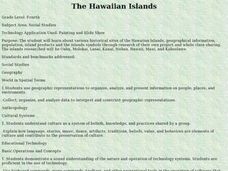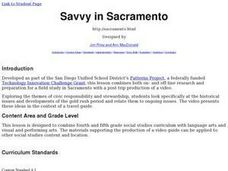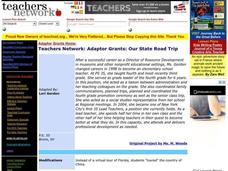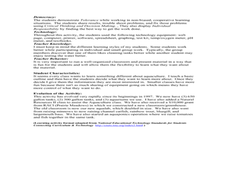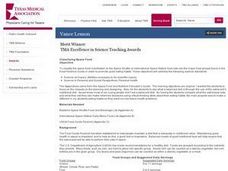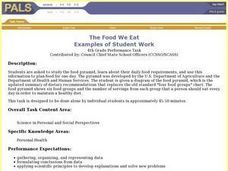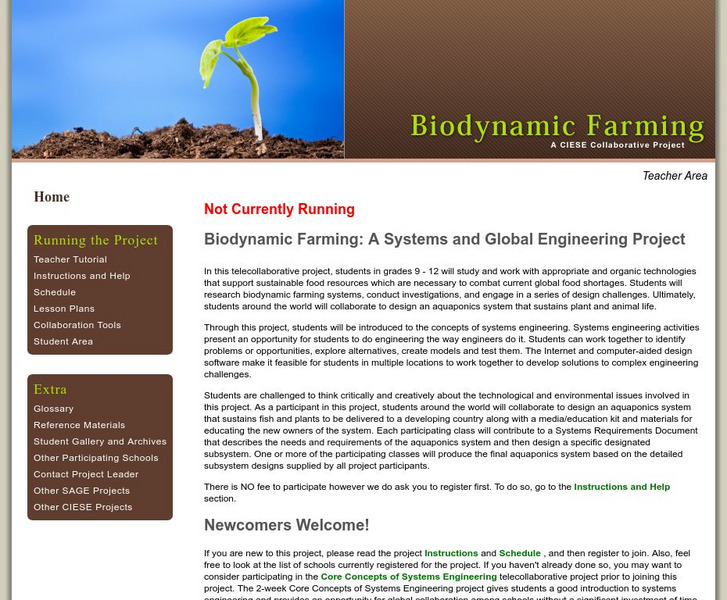Curated OER
The Hawaiian Islands
Fourth graders present information of people, places, and environments. They collect, organize, and analyze date to use with these representations.
Curated OER
Mapping the Changes
Students research an aspect of life of their choosing of a western state either before the Civil War, after the war or today. They are to write about the aspect they choose and make illustrations.
Curated OER
Water Use Around the World
Pupils compare their water use with other places around the world. They calculate the amount of water they use in a week and discuss how to conserve water. They discover the amount of clean water throughout the world.
Curated OER
No magic borders
Middle schoolers discuss what they have heard about pollution. They explore the purposes and limitations of political boundaries and borders and identify some of the causes and effects of pollution.
Curated OER
Determination of Phosphates
Young scholars engage in a laboratory instructional activity in order to increase understanding of the impact of phosphates at the chemical and ecological levels. The lab exercise is completed with the goal of getting them to predict the...
Curated OER
Aphids and Ladybirds
High schoolers record observations of ladybird beetles and aphids. They develop questions concerning the behavior of ladybird beetles and aphids that are testable by a classroom experimentation. Students develop an investigation.
Curated OER
Hog Watch
Sixth graders assume the roles of the staff of an Environmental Regulatory Agency and must assess the amount of damage caused by hog factories. Working in groups, they make recommendations that will decrease the impact of hog factories...
Curated OER
Savvy in Sacramento
Young scholars take a field trip to the state capital, Sacramento. Using the Internet, they explain the physical and human geographic features of the area and discuss interactions between the people of California between the time of...
Curated OER
Our State Road Trip
Students take a virtual tour of the country of China instead of a state. Using the Internet, they examine the differences between a political and physical map and use latitude and longitude to locate specific places. They also research...
Curated OER
Someone Like Me
Students investigate what sort of person the author is. They listen as the teacher use her notes to introduce Tom Holt briefly. Students are asked if anyone has read any of his books. They work in pairs to find more about Tom Holt as a...
Curated OER
Eat Smart. Play Hard.
Students study healthy food choices and the energy it creates for physical activity. In this food energy lesson, students complete multiple activities to learn about the benefits of healthy eating upon physical activity.
Curated OER
Aquaculture Production in the Classroom
Students study the basics of aquaculture and how to successfully raise aquatic plants and animals. In this water lesson students perform water quality tests on fish tanks, record and graph their results.
Curated OER
Lesson Plans for Painting
Students analyze the art of George Dibble and Wayne Thiebaud and complete art related activities. In this art analysis lesson, students read biographies of the two artists and descriptions of various types of painting techniques....
Curated OER
Measurement: When Degrees Matter
Eighth graders record the temperature change of the beakers. In this general science lesson plan, 8th graders create their own data table for recording observations. They discuss experimental results and cite real life applications.
Curated OER
Powerful Potato
Third graders recognize the importance of geography in shaping a settlement where people can live. In this community location lesson, 3rd graders participate in a potato growing activity to understand how it helped a community...
Curated OER
Classifying Space Food
Students write a written summary of what they have learned about the astronaut nutritional diet in comparison with their own diet habits.
Curated OER
The Food We Eat
Students plan a menu for one day after they study the food pyramid and learn about their daily food requirements. They are given an updated food pyramid with a summary fo dietary recommendations that replaces the old standard "four food...
Curated OER
Creating a Job Community
Students design their own job communities. In this art and career exploration lesson, students are placed into groups to create models of business areas based on job types.
Other
Digital Library for Earth System Education (Dlese)
This resource provides materials for teachers on a huge array of topics. Search site by topic, grade level, and desired output (such as lesson plan, case study, assessment or tutorial). Site is focused on earth science, geography, and...
Council for Economic Education
Econ Ed Link: Bringing the Market to the Farm
This printable instructional activity discusses producers and consumers from an agricultural perspective. It focuses on choices that the consumer has with regard to purchasing agricultural goods (e.g. fruits and vegetables). As an...
Center for Innovation in Engineering and Science Education, Stevens Institute of Technology
Ciese: Biodynamic Farming: A Systems and Global Engineering Project
This is an excellent project where students investigate biodynamic farming techniques. They then collaborate with students from around the world to design an aquaponics system for cultivating fish and plants that can be used in an...
University of Nebraska Omaha
Ec Ed Web: Virtual Economics Web Companion
The Virtual Economics Web Companion for K-12 economics and social studies teachers was created by the National Council on Economic Education. A wide variety of educational materials and lesson plans can be accessed through this site....
Council for Economic Education
Econ Ed Link: Peanuts, Pecans, and Peas, Please
George Washington Carver, a great scientist, changed the economy of the South with his agricultural knowledge. This lesson will investigate how the lowly peanut kept the cotton farmers from losing everything.
Council for Economic Education
Econ Ed Link: Economic Sectors and International Development
Using poverty rate as a measure of development, students select countries five at a time to compare how resources are allocated to three economic sectors (agriculture, industrial, service). After making comparisons, students will...
